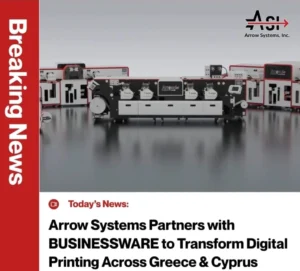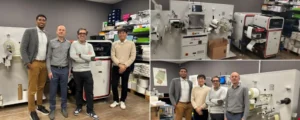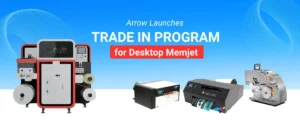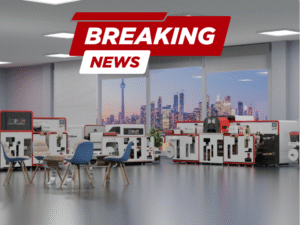Table of Contents
Making the Switch from Flexographic to Digital Printing
In today’s evolving printing industry, businesses are constantly seeking innovative solutions to meet their changing needs. One such transformation is the shift from traditional flexographic printing to the more versatile and efficient digital printing.
Arrow Systems Inc., a manufacturer of Digital label printers and cutters, understands the importance of knowing when and how to transition. In this blog post, we will explore key factors to consider when deciding to switch from flexographic printing to digital printing. We will provide insights on how to navigate this transformation successfully.
Understanding the Limitations of Flexographic Printing:
Flexographic printing has long been a reliable method for Label production, but it does come with certain limitations. This includes time-consuming setup, costly short runs, limited color choices, and the the need for specialized equipment and skilled operators.
Assessing the drawbacks of flexographic printing for your business needs will help determine the need for a transition.
Evaluating the Benefits of Digital Printing:
Digital printing offers several advantages that make it an attractive alternative to flexographic printing. These benefits include:
- Cost-Efficiency: With digital printing, there is no need for costly printing plates, leading to reduced setup times. As a result, businesses can benefit from lower costs when it comes to short-run or variable data printing. Digital printing enables on-demand printing, reducing inventory and waste.
- Customized Labels and Variable Data Printing: Digital printing allows for easy personalization of labels. Businesses that use digital printing are able to create targeted campaigns and cater to individual customer preferences.
- Faster Turnaround Times: Digital printing enables the printing of labels, making them ready for immediate use. This eliminates the need for time-consuming setup and plate changes.
- Improved Color Accuracy: Digital printing provides precise color matching. This ensures consistent quality and vibrant results even for complex designs or gradients.
- Reduced Environmental Impact: Digital printing generates less waste, as there are no printing plates or excessive setup materials. By getting rid of the need for drying time, it also reduces energy consumption.
Identifying the Right Time for Transition:
Determining the optimal time to transition from flexographic to digital printing requires careful consideration. Some factors to assess include:
- Volume and Demand: Determine your current and projected label printing volume. Digital printing is particularly beneficial for shorter runs, frequent design changes, or seasonal promotions.
- Cost Analysis: Perform a cost analysis to figure out the expenses associated with flexographic printing, including plates, setup, and waste. Compare these costs with the investment required for digital printing equipment and consumables.
- Market Demands and Trends: Monitor market trends and customer preferences. An increasing demand for customized labels, shorter lead times, or variable data printing may show it’s the right time to switch.
Implementing a Smooth Transition:
After deciding to transition to digital printing, you need a successful implementation strategy. Consider the following steps:
- Equipment Selection: Work with trusted manufacturers such as Arrow System’s Inc.. They can help you select the ideal digital label printer and cutter that aligns with your specific needs and budget.
- Staff Training: Train your operators on digital printing equipment and software to ensure a seamless transition. Familiarize them with color management, file preparation, and maintenance procedures.
- Workflow Integration: Integrate digital printing into your existing workflow and software systems. Work with your design and production teams to optimize file transfer, color management, and quality control processes.
- Test Runs and Quality Assurance: Before completing the transition, perform test runs. Use test runs to ensure that the digital prints meet both your quality standards and customer needs. Make any necessary adjustments before ramping up production.
- Continuous Improvement: Consistently monitor performance and receive feedback from customers and employees. Use this data to find areas for improvement and enhance your digital printing processes.
Conclusion:
Switching from flexographic printing to digital printing is a strategic choice. It can heavily influence your business’s efficiency, cost-effectiveness, and market share.
To navigate this transition successfully, there are key factors to take into consideration. It’s important to carefully measure the drawbacks of flexographic printing against the advantages of digital printing. You must also determine the appropriate timing for your company.
Get the right equipment, provide sufficient training, effectively combine workflows, and consistently aim for improvement. Doing this, you can access the potential of digital printing and elevate your label production capabilities.
At Arrow Systems Inc., we offer a comprehensive range of digital label printers and cutters. These include the ArrowJet Aqua series and EZCut series. We also offer inline solutions such as the ArrowJet Nova series.
Contact us today to explore how our cutting-edge technology can help you make a seamless transition to digital printing. See how you can unlock new opportunities for your business.
Contact With Our Team Now

Breaking News: Arrow Systems Partners with BUSINESSWARE to Transform Digital Printing Across Greece & Cyprus

Sid Sistemas de Impresión in Spain Installs ArrowJet Aqua 330R and DPR Taurus to Bolster Label Production

Step Inside Innovation: Arrow Systems New Experience Center Opens in Ontario, Canada.


